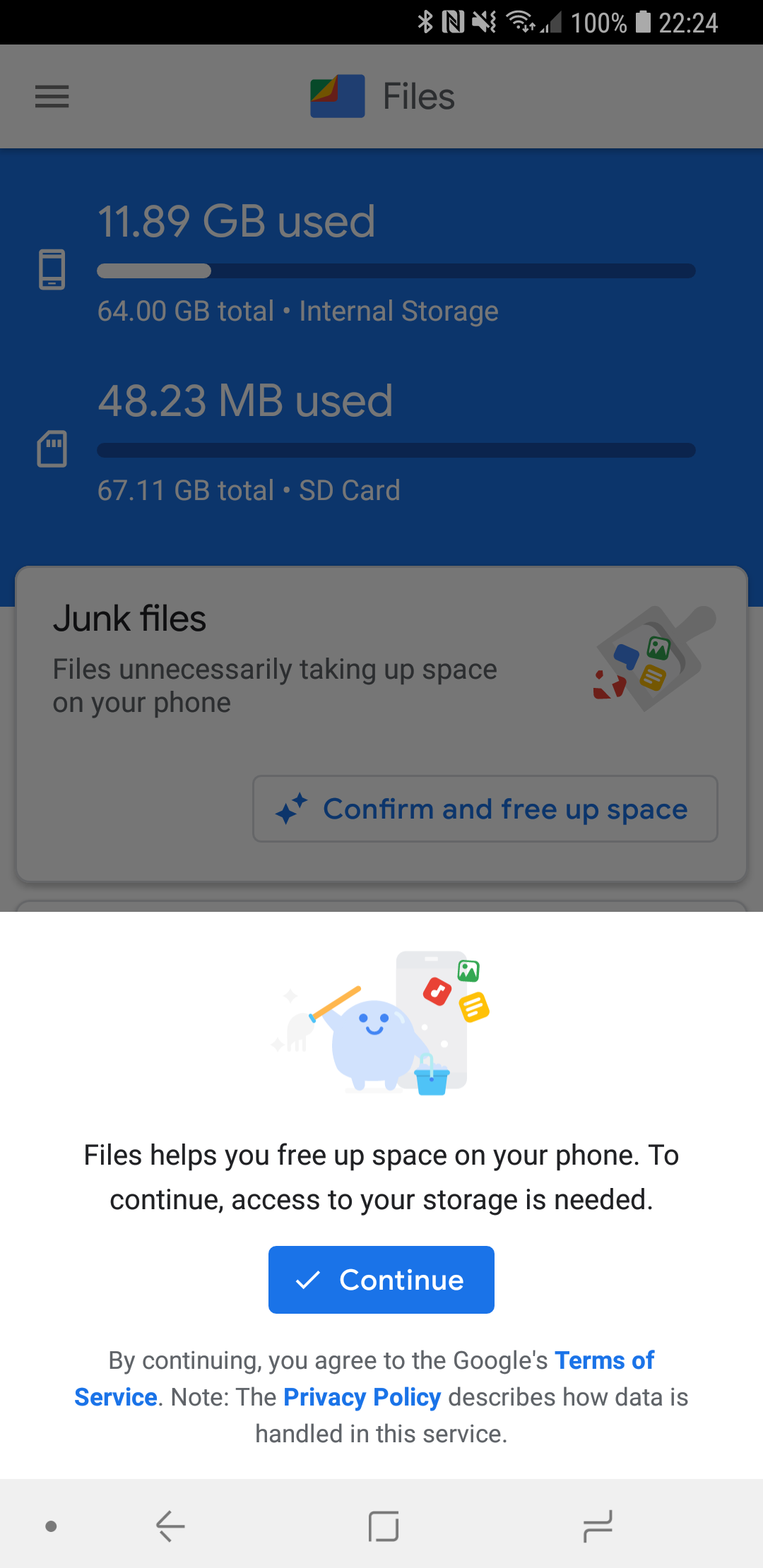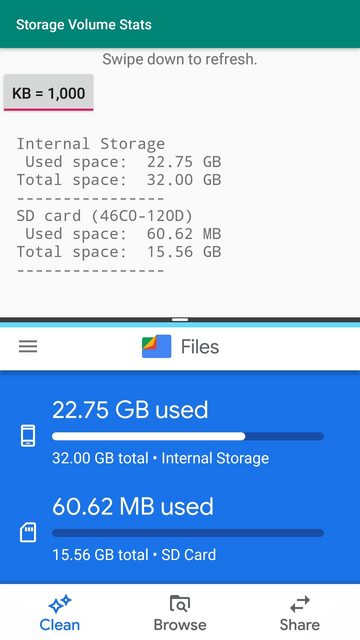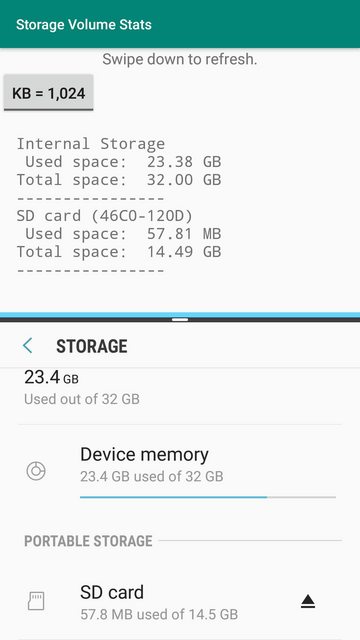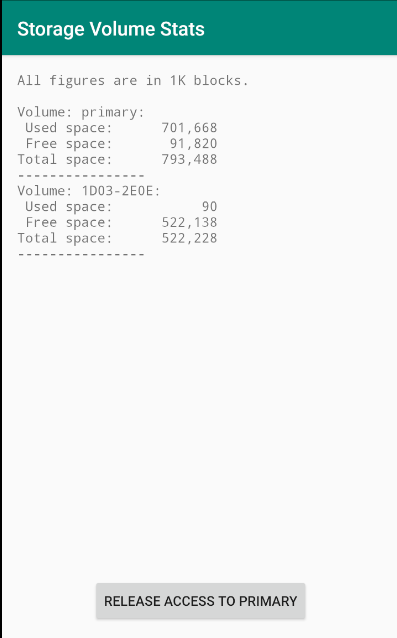Is getAllocatableBytes indeed the way to get the free space?
Android 8.0 Features and APIs states that getAllocatableBytes(UUID):
Finally, when you need to allocate disk space for large files, consider using the new allocateBytes(FileDescriptor, long) API, which will automatically clear cached files belonging to other apps (as needed) to meet your request. When deciding if the device has enough disk space to hold your new data, call getAllocatableBytes(UUID) instead of using getUsableSpace(), since the former will consider any cached data that the system is willing to clear on your behalf.
So, getAllocatableBytes() reports how many bytes could be free for a new file by clearing cache for other apps but may not be currently free. This does not seem to be the right call for a general-purpose file utility.
In any case, getAllocatableBytes(UUID) doesn't seem to work for any volume other than the primary volume due to the inability to get acceptable UUIDs from StorageManager for storage volumes other than the primary volume. See Invalid UUID of storage gained from Android StorageManager? and Bug report #62982912. (Mentioned here for completeness; I realize that you already know about these.) The bug report is now over two years old with no resolution or hint at a work-around, so no love there.
If you want the type of free space reported by "Files by Google" or other file managers, then you will want to approach free space in a different way as explained below.
How can I get the free and real total space (in some cases I got lower values for some reason) of each StorageVolume, without requesting any permission, just like on Google's app?
Here is a procedure to get free and total space for available volumes:
Identify external directories: Use getExternalFilesDirs(null) to discover available external locations. What is returned is a File[]. These are directories that our app is permitted to use.
extDirs = {File2@9489
0 = {File@9509} "/storage/emulated/0/Android/data/com.example.storagevolumes/files"
1 = {File@9510} "/storage/14E4-120B/Android/data/com.example.storagevolumes/files"
(N.B. According to the documentation, this call returns what are considered to be stable devices such as SD cards. This does not return attached USB drives.)
Identify storage volumes: For each directory returned above, use StorageManager#getStorageVolume(File) to identify the storage volume that contains the directory. We don't need to identify the top-level directory to get the storage volume, just a file from the storage volume, so these directories will do.
Calculate total and used space: Determine the space on the storage volumes. The primary volume is treated differently from an SD card.
For the primary volume: Using StorageStatsManager#getTotalBytes(UUID get the nominal total bytes of storage on the primary device using StorageManager#UUID_DEFAULT . The value returned treats a kilobyte as 1,000 bytes (rather than 1,024) and a gigabyte as 1,000,000,000 bytes instead of 230. On my SamSung Galaxy S7 the value reported is 32,000,000,000 bytes. On my Pixel 3 emulator running API 29 with 16 MB of storage, the value reported is 16,000,000,000.
Here is the trick: If you want the numbers reported by "Files by Google", use 103 for a kilobyte, 106 for a megabyte and 109 for a gigabyte. For other file managers 210, 220 and 230 is what works. (This is demonstrated below.) See this for more information on these units.
To get free bytes, use StorageStatsManager#getFreeBytes(uuid). Used bytes is the difference between total bytes and free bytes.
For non-primary volumes: Space calculations for non-primary volumes is straightforward: For total space used File#getTotalSpace and File#getFreeSpace for the free space.
Here are a couple of screens shots that display volume stats. The first image shows the output of the StorageVolumeStats app (included below the images) and "Files by Google." The toggle button at the top of the top section switches the app between using 1,000 and 1,024 for kilobytes. As you can see, the figures agree. (This is a screen shot from a device running Oreo. I was unable to get the beta version of "Files by Google" loaded onto an Android Q emulator.)
![enter image description here]()
The following image shows the StorageVolumeStats app at the top and output from "EZ File Explorer" on the bottom. Here 1,024 is used for kilobytes and the two apps agree on the total and free space available except for rounding.
![enter image description here]()
MainActivity.kt
This small app is just the main activity. The manifest is generic, compileSdkVersion and targetSdkVersion are set to 29. minSdkVersion is 26.
class MainActivity : AppCompatActivity() {
private lateinit var mStorageManager: StorageManager
private val mStorageVolumesByExtDir = mutableListOf<VolumeStats>()
private lateinit var mVolumeStats: TextView
private lateinit var mUnitsToggle: ToggleButton
private var mKbToggleValue = true
private var kbToUse = KB
private var mbToUse = MB
private var gbToUse = GB
override fun onCreate(savedInstanceState: Bundle?) {
super.onCreate(savedInstanceState)
if (savedInstanceState != null) {
mKbToggleValue = savedInstanceState.getBoolean("KbToggleValue", true)
selectKbValue()
}
setContentView(statsLayout())
mStorageManager = getSystemService(Context.STORAGE_SERVICE) as StorageManager
getVolumeStats()
showVolumeStats()
}
override fun onSaveInstanceState(outState: Bundle) {
super.onSaveInstanceState(outState)
outState.putBoolean("KbToggleValue", mKbToggleValue)
}
private fun getVolumeStats() {
// We will get our volumes from the external files directory list. There will be one
// entry per external volume.
val extDirs = getExternalFilesDirs(null)
mStorageVolumesByExtDir.clear()
extDirs.forEach { file ->
val storageVolume: StorageVolume? = mStorageManager.getStorageVolume(file)
if (storageVolume == null) {
Log.d(TAG, "Could not determinate StorageVolume for ${file.path}")
} else {
val totalSpace: Long
val usedSpace: Long
if (storageVolume.isPrimary) {
// Special processing for primary volume. "Total" should equal size advertised
// on retail packaging and we get that from StorageStatsManager. Total space
// from File will be lower than we want to show.
val uuid = StorageManager.UUID_DEFAULT
val storageStatsManager =
getSystemService(Context.STORAGE_STATS_SERVICE) as StorageStatsManager
// Total space is reported in round numbers. For example, storage on a
// SamSung Galaxy S7 with 32GB is reported here as 32_000_000_000. If
// true GB is needed, then this number needs to be adjusted. The constant
// "KB" also need to be changed to reflect KiB (1024).
// totalSpace = storageStatsManager.getTotalBytes(uuid)
totalSpace = (storageStatsManager.getTotalBytes(uuid) / 1_000_000_000) * gbToUse
usedSpace = totalSpace - storageStatsManager.getFreeBytes(uuid)
} else {
// StorageStatsManager doesn't work for volumes other than the primary volume
// since the "UUID" available for non-primary volumes is not acceptable to
// StorageStatsManager. We must revert to File for non-primary volumes. These
// figures are the same as returned by statvfs().
totalSpace = file.totalSpace
usedSpace = totalSpace - file.freeSpace
}
mStorageVolumesByExtDir.add(
VolumeStats(storageVolume, totalSpace, usedSpace)
)
}
}
}
private fun showVolumeStats() {
val sb = StringBuilder()
mStorageVolumesByExtDir.forEach { volumeStats ->
val (usedToShift, usedSizeUnits) = getShiftUnits(volumeStats.mUsedSpace)
val usedSpace = (100f * volumeStats.mUsedSpace / usedToShift).roundToLong() / 100f
val (totalToShift, totalSizeUnits) = getShiftUnits(volumeStats.mTotalSpace)
val totalSpace = (100f * volumeStats.mTotalSpace / totalToShift).roundToLong() / 100f
val uuidToDisplay: String?
val volumeDescription =
if (volumeStats.mStorageVolume.isPrimary) {
uuidToDisplay = ""
PRIMARY_STORAGE_LABEL
} else {
uuidToDisplay = " (${volumeStats.mStorageVolume.uuid})"
volumeStats.mStorageVolume.getDescription(this)
}
sb
.appendln("$volumeDescription$uuidToDisplay")
.appendln(" Used space: ${usedSpace.nice()} $usedSizeUnits")
.appendln("Total space: ${totalSpace.nice()} $totalSizeUnits")
.appendln("----------------")
}
mVolumeStats.text = sb.toString()
}
private fun getShiftUnits(x: Long): Pair<Long, String> {
val usedSpaceUnits: String
val shift =
when {
x < kbToUse -> {
usedSpaceUnits = "Bytes"; 1L
}
x < mbToUse -> {
usedSpaceUnits = "KB"; kbToUse
}
x < gbToUse -> {
usedSpaceUnits = "MB"; mbToUse
}
else -> {
usedSpaceUnits = "GB"; gbToUse
}
}
return Pair(shift, usedSpaceUnits)
}
@SuppressLint("SetTextI18n")
private fun statsLayout(): SwipeRefreshLayout {
val swipeToRefresh = SwipeRefreshLayout(this)
swipeToRefresh.setOnRefreshListener {
getVolumeStats()
showVolumeStats()
swipeToRefresh.isRefreshing = false
}
val scrollView = ScrollView(this)
swipeToRefresh.addView(scrollView)
val linearLayout = LinearLayout(this)
linearLayout.orientation = LinearLayout.VERTICAL
scrollView.addView(
linearLayout, ViewGroup.LayoutParams.MATCH_PARENT,
ViewGroup.LayoutParams.WRAP_CONTENT
)
val instructions = TextView(this)
instructions.text = "Swipe down to refresh."
linearLayout.addView(
instructions, ViewGroup.LayoutParams.WRAP_CONTENT,
ViewGroup.LayoutParams.WRAP_CONTENT
)
(instructions.layoutParams as LinearLayout.LayoutParams).gravity = Gravity.CENTER
mUnitsToggle = ToggleButton(this)
mUnitsToggle.textOn = "KB = 1,000"
mUnitsToggle.textOff = "KB = 1,024"
mUnitsToggle.isChecked = mKbToggleValue
linearLayout.addView(
mUnitsToggle, ViewGroup.LayoutParams.WRAP_CONTENT,
ViewGroup.LayoutParams.WRAP_CONTENT
)
mUnitsToggle.setOnClickListener { v ->
val toggleButton = v as ToggleButton
mKbToggleValue = toggleButton.isChecked
selectKbValue()
getVolumeStats()
showVolumeStats()
}
mVolumeStats = TextView(this)
mVolumeStats.typeface = Typeface.MONOSPACE
val padding =
16 * (resources.displayMetrics.densityDpi.toFloat() / DisplayMetrics.DENSITY_DEFAULT).toInt()
mVolumeStats.setPadding(padding, padding, padding, padding)
val lp = LinearLayout.LayoutParams(ViewGroup.LayoutParams.MATCH_PARENT, 0)
lp.weight = 1f
linearLayout.addView(mVolumeStats, lp)
return swipeToRefresh
}
private fun selectKbValue() {
if (mKbToggleValue) {
kbToUse = KB
mbToUse = MB
gbToUse = GB
} else {
kbToUse = KiB
mbToUse = MiB
gbToUse = GiB
}
}
companion object {
fun Float.nice(fieldLength: Int = 6): String =
String.format(Locale.US, "%$fieldLength.2f", this)
// StorageVolume should have an accessible "getPath()" method that will do
// the following so we don't have to resort to reflection.
@Suppress("unused")
fun StorageVolume.getStorageVolumePath(): String {
return try {
javaClass
.getMethod("getPath")
.invoke(this) as String
} catch (e: Exception) {
e.printStackTrace()
""
}
}
// See https://en.wikipedia.org/wiki/Kibibyte for description
// of these units.
// These values seems to work for "Files by Google"...
const val KB = 1_000L
const val MB = KB * KB
const val GB = KB * KB * KB
// ... and these values seems to work for other file manager apps.
const val KiB = 1_024L
const val MiB = KiB * KiB
const val GiB = KiB * KiB * KiB
const val PRIMARY_STORAGE_LABEL = "Internal Storage"
const val TAG = "MainActivity"
}
data class VolumeStats(
val mStorageVolume: StorageVolume,
var mTotalSpace: Long = 0,
var mUsedSpace: Long = 0
)
}
Addendum
Let's get more comfortable with using getExternalFilesDirs():
We call Context#getExternalFilesDirs()
in the code. Within this method a call is made to Environment#buildExternalStorageAppFilesDirs() which calls Environment#getExternalDirs() to obtain the volume list from StorageManager. This storage list is used to create the paths we see returned from Context#getExternalFilesDirs() by appending some static path segments to the path identified by each storage volume.
We would really want access to Environment#getExternalDirs() so we can immediately determine space utilization, but we are restricted. Since the call we make depends upon a file list that is generated from the volume list, we can be comfortable that all volumes are covered by out code and we can get the space utilization information we need.




